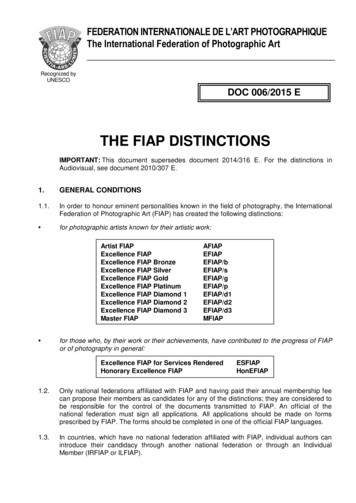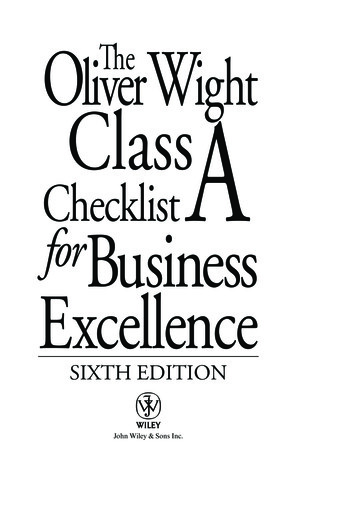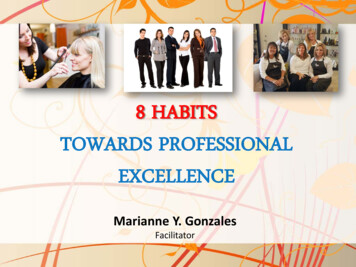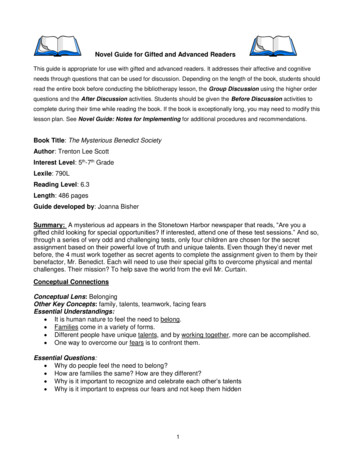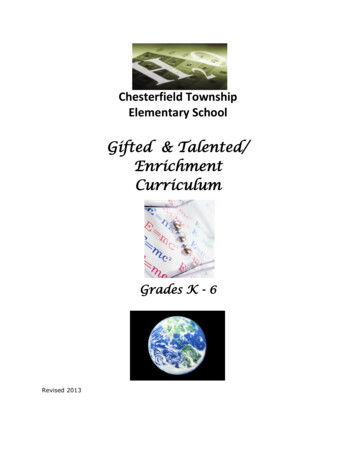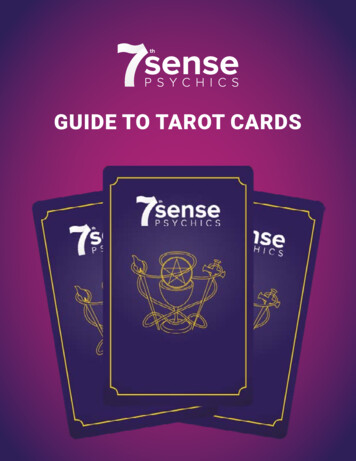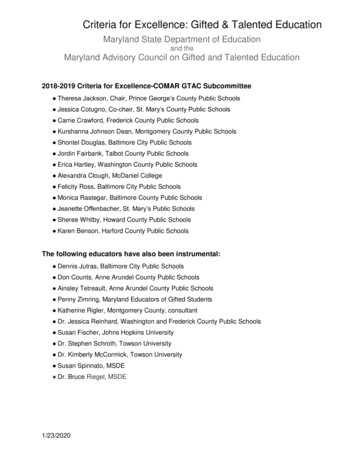
Transcription
Criteria for Excellence: Gifted & Talented EducationMaryland State Department of Educationand theMaryland Advisory Council on Gifted and Talented Education2018-2019 Criteria for Excellence-COMAR GTAC Subcommittee Theresa Jackson, Chair, Prince George’s County Public Schools Jessica Cotugno, Co-chair, St. Mary’s County Public Schools Carrie Crawford, Frederick County Public Schools Kurshanna Johnson Dean, Montgomery County Public Schools Shontel Douglas, Baltimore City Public Schools Jordin Fairbank, Talbot County Public Schools Erica Hartley, Washington County Public Schools Alexandra Clough, McDaniel College Felicity Ross, Baltimore City Public Schools Monica Rastegar, Baltimore County Public Schools Jeanette Offenbacher, St. Mary’s Public Schools Sheree Whitby, Howard County Public Schools Karen Benson, Harford County Public SchoolsThe following educators have also been instrumental: Dennis Jutras, Baltimore City Public Schools Don Counts, Anne Arundel County Public Schools Ainsley Tetreault, Anne Arundel County Public Schools Penny Zimring, Maryland Educators of Gifted Students Katherine Rigler, Montgomery County, consultant Dr. Jessica Reinhard, Washington and Frederick County Public Schools Susan Fischer, Johns Hopkins University Dr. Stephen Schroth, Towson University Dr. Kimberly McCormick, Towson University Susan Spinnato, MSDE Dr. Bruce Riegel, MSDE1/23/2020
Maryland Criteria for Excellence: Gifted and Talented Education (2019 version)1I.FOREWORDAll students in Maryland's schools must be provided educational opportunities appropriate to theirindividual abilities to enable them to reach their maximum potential. Gifted and talented students areone group, which has unique abilities and needs. Gifted and talented students are found in youth fromall cultural groups, across all economic strata, and in all areas of human endeavor (MarylandAnnotated Code, §8-202).The original Criteria for Excellence: Gifted and Talented Program Guidelines (1983) was developed asa collaborative effort by the staff of the Maryland State Department of Education and personnel havingresponsibilities for gifted and talented programs and services in the LSSs. This document was updatedin 2015 and 2018-2019.Educators in Maryland will find this document of value in planning, implementing, and evaluatingprograms and services to meet the needs and challenge the abilities of gifted and talented students.II.INTRODUCTIONThe Maryland State Department of Education recognizes the importance of providing educationalprograms that provide all children and youth with opportunities to develop their abilities to themaximum. Gifted and talented students, like students in many other student groups, possess uniqueabilities, interests, and needs, which can be addressed only through differentiating the regularcurriculum and designing specialized programs and services.This publication sets forth the criteria for excellence in programs and services for gifted and talentedstudents. Six major program components have been addressed: Identification of Students Instructional Program Professionally Qualified Teachers Professional Learning Program Management EvaluationThe criteria which establish optimal practices are listed for each program component. They define"what should be" in excellent programs and services for gifted and talented students. The criteriaprovide direction to school systems and individual schools as they plan, develop, and implement newprograms and services. They are also intended as a tool for schools to use in assessing and improvingtheir current offerings.The Annotated Code of Maryland §8-201 defines a gifted and talented student as "an elementary orsecondary student who is identified by professionally qualified individuals as having outstanding talentand performing, or showing the potential for performing, at remarkably high levels of accomplishment
Maryland Criteria for Excellence: Gifted and Talented Education (2019 version)2when compared with other students of a similar age, experience or environment.” A gifted andtalented student is one who Exhibits high-performance capability in intellectual, creative, or artistic areas; Possesses an unusual leadership capacity; or Excels in specific academic fields.A gifted and talented student needs different services beyond those normally provided by the regularschool program to develop the student’s potential (Annotated Code of Maryland §8-202). By thisdefinition, Maryland subscribes to the multidimensionality of giftedness, seeking to develop programsand services that serve students who are intellectually gifted or excel in specific academic fields andalso those students who excel in creativity, the arts, or leadership. It must be noted that no oneprogram serves all gifted students, as their needs, like those of all students, are unique andindividual, but some gifted students may require highly specialized programs and services.COMAR 13A.04.07 Gifted and Talented Education requires all Maryland school systems to“ establish a process for identifying gifted and talented students as they are defined in EducationalArticle Paragraph §8-201 ” “ to provide different services beyond those normally provided by theregular school program to develop the gifted and talented student’s potential and to review theeffectiveness of its programs and services.” COMAR 13A.04.07 also states that “teachers and otherpersonnel assigned specifically to work with students who have been identified as gifted and talentedshall engage in professional learning aligned with the competencies specified by the Gifted andTalented Education Specialist endorsement, COMAR 13A.12.03.12.The goal of gifted education in Maryland is to identify and serve gifted and talented students andyouth “from all cultural groups, across all economic strata, and in all areas of human endeavor (§8202).” While the number of gifted and talented students who need a differentiated program will vary,they exist in every school setting.III.CRITERIA1.0 Identification of StudentsAn identification process ensures that all gifted and talented students are recognized so thatthey can be appropriately served. The process identifies students performing at remarkablyhigh levels of accomplishment as well as those showing the potential for performing atremarkably high levels when compared with other students of a similar age, experience, orenvironment. (§8-201)Multiple measures are used for screening and identification and include a measure ofcognitive ability given to every student. Additional measures used to confirm placement inservices include achievement tests, behavioral checklists, and/or supplemental measures as
Maryland Criteria for Excellence: Gifted and Talented Education (2019 version)3appropriate. There are appropriate procedures and criteria for giftedness developed for eachof the various areas: general intellectual capability, creative, or artistic areas, outstandingleadership capacity, and specific academic fields. Information about a student’s specificabilities and program needs obtained through the identification process serves as a basis forplanning the student’s instructional program. In this way, the identification process is anintegral part of the overall instructional program and should enhance the responsiveness ofthe school to the needs of all students.Students must be identified early in their academic careers, which is particularly important forthe identification of students from historically underrepresented populations. Theidentification process shall use universal screening and multiple indicators of potential,aptitude, ability, and achievement from an annually reviewed Maryland State Department ofEducation approved list of assessments and checklists.A universal screening process shall be used to identify a significant number of students inevery school and at least 10 percent in each LSS, as early as possible, but no later thanGrade 3. Additional identification shall occur at the 3 – 5 and 6 – 9 grade bands forparticipation in the programs and services described in Regulation .03 of the regulation.As of August 2019, Johns Hopkins University, Notre Dame of Maryland University, TowsonUniversity, and McDaniel College each offer State-approved graduate programs leading toendorsement as a Gifted and Talented Education Specialist. Educators with thisendorsement can be a resource to schools and school districts developing programs for theirgifted and talented students.1.1 The Process of IdentificationIdentification procedures and criteria are specific to the areas of giftedness being assessedand are directly related to specific programs and services provided to the student.Instruments and procedures used in the identification process are as unbiased as possiblewith respect to race, culture, ethnicity, socioeconomic background, religion, national origin,gender, or exceptionality. No single assessment shall prevent a student from being identified.The process of identifying students with demonstrated or potential giftedness includes:1.1.1 Early broad-based screening for cognitive ability of the total school populationto ensure that all potentially gifted students have an opportunity to beconsidered.1.1.2 Achievement data must be used to further screen for giftedness.
Maryland Criteria for Excellence: Gifted and Talented Education (2019 version)41.1.3 Alternate assessments should be used as appropriate to ensure equitableidentification, particularly among historically underserved populations.1.1.4 A universal screening process shall be used to identify students in everyschool as early as possible, but no later than Grade 3. Additionalidentification shall occur at the 3 to 5 and 6 to 9 grade bands forparticipation in the programs and servicesMSDE Approved Assessments and ChecklistsCognitive Ability AssessmentsGroup Administered Cognitive Abilities Test(CogAT) Naglieri NonverbalAssessment (NNAT) Otis-Lennon School AbilityAssessment (OLSAT) Terra Nova InView ofCognitive SkillsIndividually Administered Stanford/Binet Wechsler Preschool PrimaryScale of Intelligence (WPPSI) Woodcock-Johnson Test ofCognitive Ability Wechsler Intelligence Scalefor Children (WISC)Aptitude and Achievement Assessments ACTPSAT/SATSchool and College Ability (SCAT) Testi-Ready Mathematics and ReadingAchievement AssessmentsNorthwest Evaluation Association Measuresof Academic Progress (NWEA MAP) Readingor MathematicsState Achievement AssessmentsPartnership for Assessment and Readiness forCollege Careers (PARCC) ExamPerformance Series: Reading andMathematicsStanford Achievement Test SeriesTest of Mathematical Abilities for GiftedStudents (TOMAGS)Screening Assessment for Gifted Elementaryand Middle School Students (SAGES)Woodcock-Johnson Individual AchievementTestsMaryland Comprehensive AchievementProgram (MCAP)Amplify ELAmCLASS: Dynamic Indicators of Basic EarlyLiteracy Skills (DIBELS)mCLASS: Text Reading Comprehension (TRC)Electronic Ready Inventory (ERI)Alternate Assessments Torrance Test ofCreativity ACCESS for ELs Clarks Drawing AbilityTest (CDAT) Profile of CreativeAbilities (PCA) Cebeci Test ofCreativity (CTC) Screening Assessmentfor Gifted Elementaryand Middle SchoolStudents (SAGES)1.1.5 Behavioral checklists and other supplemental information, as listed in thefollowing chart of MSDE approved, valid, and reliable qualitative andquantitative assessment methods should be used as appropriate toensure equitable identification, particularly among historically underservedpopulations.Behavioral ChecklistsSupplemental Information Student Interviews Student portfolios (including rough drafts, planningsketches, to record idea development) Primary Talent Development (PTD) portfolios Student auditions, exhibits, shows for media, andthe fine and performing arts Nominations Districtwide Local Performance AssessmentsGifted Evaluation Scale (GES -3)Slocomb Payne Teacher Perception InventoryRenzulli ScalesTeacher Observation of Potential in Students (TOPS)HOPE Teacher Rating ScaleGifted and Talented Evaluation Scales (GATES)
Maryland Criteria for Excellence: Gifted and Talented Education (2019 version)51.2 The LSS process for screening and identification is clearly stated andconsistently implemented throughout the school system and annually reportedto all stakeholders.1.2.1 Each LSS should evaluate and monitor, year-to-year, its identified giftedpopulation as a reflection of the demographics of its student populationusing disaggregated data annually.1.2.2 Part of this evaluation must include an investigation of proportionality ofstudent representation (at a minimum: race, ethnicity, gender, SES, andEL).1.2.3 Twice-exceptional students must be identified in each LEA.1.2.4 Gifted students must be flagged in the LEA student data system.1.3 Implementation of the identification process includes training for all school staffin characteristics of gifted and talented students, including underservedpopulations and twice-exceptional learners, the identification procedures andcriteria, and the instruments and techniques used to identify gifted and talentedstudents.1.4 Schools are encouraged to create a school-based committee consisting ofteachers, the principal or assistant principal, and other professional staffmembers who collect and analyze student identification data to support formalidentification by the district.1.5 In addition to universal identification procedures, additional nominations may bereferred by parents, teachers, peers, self, or others. Information about studentsis obtained from multiple sources who have first-hand knowledge of thestudent’s performance or potential.1.6 Identification of gifted and talented students is an ongoing process extendingfrom school entry through grade 12. Opportunities are provided for students tobe considered for gifted and talented education programs and servicesthroughout their school experience.1.7 Each LEA must develop and implement procedures for notifyingparents/guardians of the results of the identification process, including anappeals process, and an explanation of services available to gifted learners.2.0 Curriculum and InstructionCurriculum and instruction must challenge the advanced academic needs of gifted and talentedstudents. The regular instructional program must be differentiated to meet the unique learningstyles, learning rates, interests, abilities, and needs of gifted and talented students during theinstructional day. The differentiated instructional program includes both elements that aredifferent from and elements that are similar to those in the regular program for their
Maryland Criteria for Excellence: Gifted and Talented Education (2019 version)6chronological peers. While some aspects of the regular curriculum can be adapted, others willneed to be added which may be unique to the gifted and talented students.Appropriate programs and services for gifted and talented students reflect the differentiation ofcontent (what is taught and when - sequence and pacing), instructional strategies (how contentis delivered), products (opportunities to demonstrate and apply learning) and the learningenvironment (the context in which learning occurs). Both enrichment, diving deeper into contentusing interdisciplinary approaches, and acceleration, providing content above chronologicalgrade level, can be utilized as differentiation approaches.CONTENT2.1 The instructional program provides opportunities for gifted and talented students todemonstrate proficiency in the concepts and skills of the regular curriculum.2.1.1 A pre-assessment is made to determine what students already know, andprovisions are made for rapid, efficient learning of concepts and skills notyet acquired.These may include: Diagnostic AssessmentsEnd-of-year AssessmentsUnit AssessmentsDevelopmental Reading Assessment (DRA)/Running RecordsMost Difficult FirstStandardized TestingTeacher prepared pretestsWriting promptsStudent Learning Objective (SLO) DataMAP-R DataMAP-M DataPlanning Sketches, Product ProposalsProfessional Level Participation (internships, performing arts)Informal pre-assessments may include: KWLEntrance TicketsExit TicketsAnticipation GuidesConcept MapsInformation SurveysInterest InventoriesPicture InterpretationVisual Thinking RepresentationsQuestionnairesStudent Interviews
Maryland Criteria for Excellence: Gifted and Talented Education (2019 version)7 Student demonstrations Parent interviews or checklists2.1.2 Extended learning experiences are provided for a more in-depthexamination of topics present in the regular curriculum and theexamination of topics related to, but not included in the regularcurriculum.Extended learning experiences may include: National History DayOriginal Research Investigation/Research PracticumRenzulli’s Schoolwide Enrichment Model (SEM)DebateTED X Clubs/PresentationIndependent Studies/Passion Projects/Resident ExpertsShared Inquiry/Socratic Seminar DiscussionsGuest experts (live or virtual)Field trips (live or virtual)STEM/STEAM FairInvention eative Problem Solving Competitions2.2 Content of the curriculum focuses on the universal concepts which remain constantover time and across all disciplines and cultures.Universal concepts may include but are not limited to: ternsForcePowerExplorationOrder vs. ChaosCommunityStructureAdaptations2.3 Place greater emphasis on the development and application of creative- and criticalthinking skills.Creative-thinking models or frameworks may include: E. Paul Torrance’s Creativity Framework
Maryland Criteria for Excellence: Gifted and Talented Education (2019 version)8 Williams’ Taxonomy of Creativity Creative Problem-SolvingCreative thinking strategies may include: SCAMPER Divergent Questioning Morphological MatricesCritical-thinking models or frameworks may include: Paul’s Reasoning Model Kaplan’s Depth and Complexity Model De Bono’s Six HatsCritical-thinking strategies may include: Analogies Synectics/Forced Association2.4 Curriculum design includes interdisciplinary or transdisciplinary studies requiring theintegration of both concepts and methodologies from different disciplines, including: Concept-based InstructionProblem Based LearningIntegrated Curriculum ModelKaplan’s Depth and Complexity ModelInquiry-Based InstructionUniversal Design for Learning2.5 Opportunities are provided to explore, develop, or research students’ areas ofinterest and/or talent for the acquisition of a broad base of knowledge through astudy of a wide range of subjects that the general education curriculum may notinclude.A wide range of subjects may include: Emerging technologiesWorld languages/culturesExploration of the artsGlobal issuesLeadershipEnvironmental Issues/TopicsBias/Propaganda2.6 Challenging and diverse resources representing a variety of cultures should beused, including: primary sourcesspecialized reference materialstechnologyexperts in the field
Maryland Criteria for Excellence: Gifted and Talented Education (2019 version)92.7 A variety of acceleration opportunities are available and can be found in A NationEmpowered Early admission to kindergartenEarly admission to first gradeGrade-skipping (or whole-grade acceleration)Continuous progressSelf-paced instructionSubject-matter acceleration/partial acceleration (Or content-based acceleration)Combined classesCurriculum compactingTelescoping curriculumMentoringExtracurricular programs Distance learning or online learning coursesConcurrent/Dual enrollmentAdvanced Placement International Baccalaureate programmeAccelerated/honors high school or residential high school on a college campusCredit by examinationEarly entrance into middle school or high schoolEarly graduation from high school or collegeINSTRUCTIONAL STRATEGIES2.8 Instructional strategies for gifted and talented students provide greater learnerinvolvement in educational decision-making.These include: Choice of materials, activities, products and/or content;Development of criteria for self-assessment;Self-evaluation of products and processes;Diverse opportunities to create and invent in areas of individual interest;Exposure to alternative educational accelerated options, including goal settingand processes and empowerment to develop a unique program; Choice of strategies and modalities to approach content; and Choice of outcomes and /or forms of products.2.9 Instructional strategies for gifted and talented students are selected to promote anearlier development as an independent learner.These include involving the student in: Kaplan’s Disciplinary ThinkingMethodology for primary and secondary research;Problem-solving;Use of predetermined evaluation criteria by student and teacher;Use of productivity expectations in the assignment of tasks; andCreation of original products that demonstrate and apply understanding at anadvanced level.
Maryland Criteria for Excellence: Gifted and Talented Education (2019 version)10 Use of Primary Talent Development thinking behaviors Resourceful Creative Communicative Leadership Persistent Perceptive Inquisitive Logic Spatial Reasoning Visual Reasoning Advanced observation skills Memory2.10 Instructional strategies for gifted and talented students are selected to elicit thestudents' use of higher-level critical and creative-thinking skills at an earlier age andin greater depth.These strategies include involving the student in: Convergent and divergent production;Questioning strategies which focus on analyzing, synthesizing and creatingProblem seeking as well as problem-solving;Open-end problems;Paul’s Reasoning Model All reasoning has a purpose All reasoning is an attempt to figure something out, settle a question, solve aproblem All reasoning is based on assumptions All reasoning is done from some point of view All reasoning is based on data, information, and evidence All reasoning is expressed through, and shaped by, concepts and ideas All reasoning contains inferences by which we draw conclusions and givemeaning to data All reasoning leads somewhere, has implications and consequences Kaplan’s Depth and Complexity Big Idea Tools of the Discipline Details Rules Patterns
Maryland Criteria for Excellence: Gifted and Talented Education (2019 version)11 Trends Ethics Multiple Perspectives Relate Over Time Across Disciplines Predicting, hypothesizing, collecting and verifying data, and forming supportableconclusions; and Complex and abstract reasoning.2.11 Instructional strategies for gifted and talented students require the teacher tobecome a facilitator of learning and a manager of resources.Teachers should: Provide a structure in which students are active participants; Implement interventions to address the unique academic, social, emotional andasynchronous needs of gifted and talented students; Use a balance of expository and inquiry approaches; Demonstrate a continuing development of their knowledge base; Provide a climate encouraging creativity and appropriate intellectual risk-taking; Monitor academic progress to ensure that students make commensurate growthbased on pre- and post-assessment data; Provide access for students to use technology as appropriate.2.12 Instructional strategies selected promote gifted and talented students’ in-depthunderstanding of self and society.These include: Analyzing the self as an individual and as a member of a group;Learning how to work constructively and cooperatively with others;Learning how to modify personal and group behavior;Learning how to make productive contributions to society, andLearning how to use metacognitive strategies may include but not limited to Self-reflection Goal setting (cognitive and affective) Learning how to address affective needs, may include but not limited to Cooperation Respect Self-Image Responsibility Self-Regulation Self-Esteem Empathy Grit / Resilience Intrinsic Motivation
Maryland Criteria for Excellence: Gifted and Talented Education (2019 version)12 Curiosity Divergent Thinking Self-Efficacy Growth from Failure Acceptance of Ambiguity Goal AttainmentLEARNING ENVIRONMENT2.13 A variety of instructional groupings based upon individual program components andtheir objectives, number, and needs of gifted and talented students, and availableresources are used to facilitate differentiated instruction, which may include: Homogeneous grouping of identified gifted and talented students for aspecific content area;Flexible homogeneous grouping based on pre-assessment (readiness);Homogeneous cluster grouping within heterogeneous classes;Cross grade-level grouping;Independent study; andFlexible grouping based on interest or learning profile2.14 Various administrative arrangements are used to promote interaction among giftedand talented students and their chronological-aged peers as well as among theirintellectual or artistic/creative peers.2.15 Resources beyond the school setting are used to provide appropriate educationalexperiences for gifted and talented students, which may include collaboration with: Community agencies;Cultural institutions;Businesses;Colleges and universities;Maryland Mentorships Initiative; andExperts in various fields.Appropriate services for gifted and talented students may include: Mentorships;Community service;Summer learning experiences;Internships;Distance learning courses;Dual enrollment; andContests and competitions, which may include: Science/STEM/STEAM Fairs Battle of the Books Coding Clubs
Maryland Criteria for Excellence: Gifted and Talented Education (2019 version)13 Destination Imagination Letters About Literature Math 24 Game Math Olympiads Math Counts Maryland Math Engineering, & Science Achievement (MESA) National History Day Odyssey of the Mind Robotics Competitions Science Olympiads STEM competitions SEAPerch (underwater robotics) Art Exhibitions Theatre Performances3.0 Professionally Qualified TeachersAs of August 2019, Johns Hopkins University, Notre Dame of Maryland University, TowsonUniversity, and McDaniel College offer State-approved graduate programs leading toendorsement as a Gifted and Talented Education Specialist (COMAR 13A.12.03.12). Educatorswith this endorsement can be a resource to schools and school districts developing programs fortheir gifted and talented students.3.1 A process to ensure the selection of professionally qualified teachers for giftedand talented students is established and clearly articulated.Qualifications may include: Evidence of specific training, professional learning, and/or formal education ingifted education; Successful teaching experience, especially with gifted and talented students; A genuine interest in and desire to work with gifted and talented students; Demonstrated evidence of advanced content competence. Demonstrated evidence of culturally responsive teaching.3.1 Criteria for the selection of teachers is based on a set of competencies andcharacteristics supported by research as being important to effective teaching ofgifted and talented students.Included in this set are: An awareness of the cognitive and affective needs of gifted and talentedstudents and a desire to teach them, “including those from diverse cultural andlinguistic backgrounds, and identify their related academic and social-emotionalneeds”
Maryland Criteria for Excellence: Gifted and Talented Education (2019 version)14 Expertise in content and evidenced-based instructional methods;Expertise in the use of technology to support instruction;Ability to impart intellectual curiosity and enthusiasm for learning to students;High level of energy, enthusiasm, confidence, and resourcefulness;Ability to organize and manage instruction to provide for a balance of structure andflexibility;Openness to innovation and acceptance of divergent, creative thinking;Security in dealing with intellectual precocity;Ability to facilitate students' independence and development of personalresponsibility for their learning;Willingness to pursue training for needed professional understanding andcompetencies; andExpertise in the collection, management, and analysis of assessment data.4.0 Professional LearningRapidly increasing knowledge about the developmental patterns and learning styles of gifted andtalented students and appropriate programs and services necessitate ongoing, high-qualityprofessional learning and professional learning as components of a successful program.4.1 Professional learning opportunities in gifted and talented education are providedfor all school, and central office staff involved in the education of gifted andtalented students, which includes, but is not limited to, teachers of gifted andtalented students, special education teachers, professional school counselors,school specialists, EL teachers, school administrators, student servicespersonnel, supervisors, content specialists, and other office staff for which it isappropriate.4.2 Professional learning opportunities in gifted and talented education areprovided, including a background of general knowledge about the characteristicsof giftedness and implications for curriculum, instruction, and assessment.Specific content includes: Characteristics and identification of gifted and talented students; Twice-exceptional Gifted students from low socio-economic backgrounds Gifted English Learners Gifted learners from culturally and ethnically diverse backgrounds Developmental, social, and emotional needs; Asynchronous development Dual and misdiagnoses Relationship building Overexcitabilities Advocating
Maryland Criteria for Excellence: Gifted and Talented Education (2019 v
As of August 2019, Johns Hopkins University, Notre Dame of Maryland University, Towson University, and McDaniel College each offer State-approved graduate programs leading to endorsement as a Gifted and Talented Education Specialist. Educators with this endorsement can be a resource to schools and
